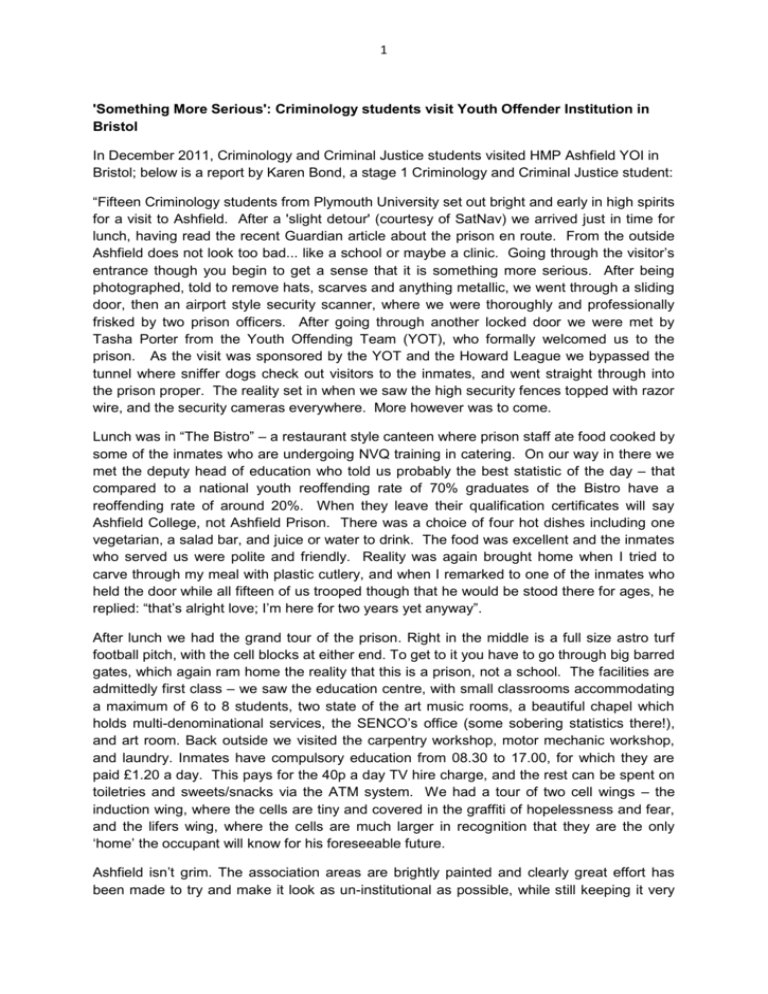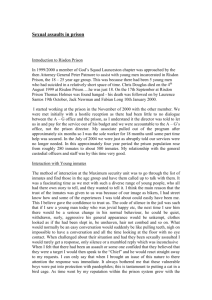`Something More Serious` - Criminology students visit
advertisement

1 'Something More Serious': Criminology students visit Youth Offender Institution in Bristol In December 2011, Criminology and Criminal Justice students visited HMP Ashfield YOI in Bristol; below is a report by Karen Bond, a stage 1 Criminology and Criminal Justice student: “Fifteen Criminology students from Plymouth University set out bright and early in high spirits for a visit to Ashfield. After a 'slight detour' (courtesy of SatNav) we arrived just in time for lunch, having read the recent Guardian article about the prison en route. From the outside Ashfield does not look too bad... like a school or maybe a clinic. Going through the visitor’s entrance though you begin to get a sense that it is something more serious. After being photographed, told to remove hats, scarves and anything metallic, we went through a sliding door, then an airport style security scanner, where we were thoroughly and professionally frisked by two prison officers. After going through another locked door we were met by Tasha Porter from the Youth Offending Team (YOT), who formally welcomed us to the prison. As the visit was sponsored by the YOT and the Howard League we bypassed the tunnel where sniffer dogs check out visitors to the inmates, and went straight through into the prison proper. The reality set in when we saw the high security fences topped with razor wire, and the security cameras everywhere. More however was to come. Lunch was in “The Bistro” – a restaurant style canteen where prison staff ate food cooked by some of the inmates who are undergoing NVQ training in catering. On our way in there we met the deputy head of education who told us probably the best statistic of the day – that compared to a national youth reoffending rate of 70% graduates of the Bistro have a reoffending rate of around 20%. When they leave their qualification certificates will say Ashfield College, not Ashfield Prison. There was a choice of four hot dishes including one vegetarian, a salad bar, and juice or water to drink. The food was excellent and the inmates who served us were polite and friendly. Reality was again brought home when I tried to carve through my meal with plastic cutlery, and when I remarked to one of the inmates who held the door while all fifteen of us trooped though that he would be stood there for ages, he replied: “that’s alright love; I’m here for two years yet anyway”. After lunch we had the grand tour of the prison. Right in the middle is a full size astro turf football pitch, with the cell blocks at either end. To get to it you have to go through big barred gates, which again ram home the reality that this is a prison, not a school. The facilities are admittedly first class – we saw the education centre, with small classrooms accommodating a maximum of 6 to 8 students, two state of the art music rooms, a beautiful chapel which holds multi-denominational services, the SENCO’s office (some sobering statistics there!), and art room. Back outside we visited the carpentry workshop, motor mechanic workshop, and laundry. Inmates have compulsory education from 08.30 to 17.00, for which they are paid £1.20 a day. This pays for the 40p a day TV hire charge, and the rest can be spent on toiletries and sweets/snacks via the ATM system. We had a tour of two cell wings – the induction wing, where the cells are tiny and covered in the graffiti of hopelessness and fear, and the lifers wing, where the cells are much larger in recognition that they are the only ‘home’ the occupant will know for his foreseeable future. Ashfield isn’t grim. The association areas are brightly painted and clearly great effort has been made to try and make it look as un-institutional as possible, while still keeping it very 2 highly secure. In the six years it has been open there has not been a single successful suicide, although staff admit that there are many attempts. While we did experience a great deal of banter from the lads that we saw on our tour round the facility, it was comparable to the sort of thing you would hear while out in any town on a Saturday night. Indeed one lad who was playing football asked us where we were from and told us he hoped we had a nice day. The majority of the staff I spoke to were positive about their role, and realistic about what they could hope to achieve. But I came away saddened by what I had seen. Yes there were some big, tough looking lads – but there were also some small, sad, frightened looking boys. We spoke to one lad who had been there two months – while talking to him a prison officer came to tell him he had a visitor and he was clearly unnerved, repeating over and over that nobody had visited him before and that he did not know who it could be as none of his family would bother. The majority of the inmates are British Minority Ethnic (and this is NOT reflected in the staff make up) and 100% of them are children. I lost count of the number of locked doors I had to go through during the four hours I spent there, and when I left I felt guilty that I was going home to my family, with the prospect of a happy Christmas just around the corner. Tasha, the YOT worker who gave us the tour was clearly incredibly enthusiastic about her job and the change that she can see in some of the boys she works with, but kept saying that we have to remember the victims. I can’t help feeling that the inmates are just as much victims as the people they have offended against.” Thanks to Karen for a compelling description of the trip, which really helps to question some of the assumptions made by many about Youth Offender Institutions and their inhabitants.











